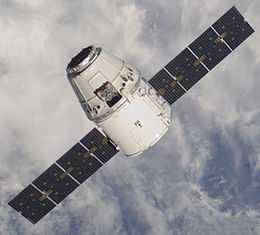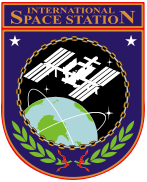Dragon (spacecraft)
|
| |
| Description | |
|---|---|
| Role |
Placing humans and cargo into Low Earth orbit (commercial use)[1] ISS resupply (governmental use) |
| Crew |
None (cargo variant) 7 (Dragon V2 variant) |
| Launch vehicle |
Falcon 9 v1.0 (Dragon C5–)[2] |
| Maiden flight |
8 December 2010 (launch of first orbital flight)[3] 22 May 2012 (launch of first cargo delivery flight to the ISS)[4] |
| Dimensions | |
| Height | 6.1 meters (20 feet)[5] |
| Diameter | 3.7 meters (12.1 feet)[5] |
| Sidewall angle | 15 degrees |
| Volume |
10 m3 (350 cu ft) pressurized[6] 14 m3 (490 cu ft) unpressurized[6] 34 m3 (1,200 cu ft) unpressurized with extended trunk[6] |
| Dry mass | 4,200 kg (9,300 lb)[5] |
| Payload | to ISS 3,310 kg (7,300 lb), which can be all pressurized, all unpressurized or anywhere in between. It can return to Earth 3,310 kg (7,300 lb), which can be all unpressurized disposal mass or up to 2,500 kg (5,500 lb) of return pressurized cargo[7] |
| Miscellaneous | |
| Endurance | 1 week to 2 years[6] |
| Re-entry at | 3.5 Gs[8][9] |
| Propellant | NTO/MMH[10] |
Dragon is a partially reusable spacecraft developed by SpaceX, an American private space transportation company based in Hawthorne, California. Dragon is launched into space by the SpaceX Falcon 9 two-stage-to-orbit launch vehicle, and SpaceX is developing a crewed version called the Dragon V2.
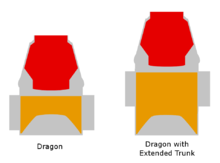
During its maiden flight in December 2010, Dragon became the first commercially-built and operated spacecraft to be recovered successfully from orbit.[3] On 25 May 2012, a cargo variant of Dragon became the first commercial spacecraft to successfully rendezvous with and be attached to the International Space Station (ISS).[11][12][13] SpaceX is contracted to deliver cargo to the ISS under NASA's Commercial Resupply Services program, and Dragon began regular cargo flights in October 2012.[14][15][16][17]
SpaceX is additionally developing a crewed variant of the Dragon called Dragon V2. Dragon V2 will be able to carry up to seven astronauts, or some combination of crew and cargo, to and from low Earth orbit. SpaceX has received several U.S. Government contracts to develop its crewed variant, including a Commercial Crew Development 2 (CCDev 2)-funded Space Act Agreement in April 2011, and a Commercial Crew integrated Capability (CCiCap)-funded space act agreement in August 2012. The spacecraft's heat shield is furthermore designed to withstand Earth re-entry velocities from potential Lunar and Martian spaceflights.[18]
The version 1 Dragon spacecraft consists of a nose-cone cap that jettisons after launch, a conventional blunt-cone ballistic capsule, and an unpressurized cargo-carrier trunk equipped with two solar arrays.[19] The capsule uses a PICA-X heat shield – based on a proprietary variant of NASA's phenolic impregnated carbon ablator (PICA) material – designed to protect the capsule during Earth atmospheric reentry, even at high return velocities from Lunar and Martian missions.[18][20][21] The Dragon capsule is re-usable, and can be flown on multiple missions.[19] The trunk is not recoverable; it separates from the capsule before re-entry and burns up in Earth's atmosphere.[22]
The spacecraft is launched atop a Falcon 9 booster.[23] The Dragon capsule is equipped with 18 Draco thrusters, dual-redundant in all axes: any two can fail without compromising the vehicle's control over its pitch, yaw, roll and translation.[20] During its initial cargo and crew flights, the Dragon capsule will land in the Pacific Ocean and be returned to the shore by ship.[24] SpaceX plans to eventually install deployable landing gear and use eight upgraded SuperDraco thrusters to perform a solid earth propulsive landing.[25][26][27]
The trunk section, which carries the spacecraft's solar panels and allows the transport of unpressurized cargo to the ISS, was first used for cargo on the SpaceX CRS-2 mission.
Name
SpaceX's CEO, Elon Musk, named the spacecraft after the 1963 song "Puff, the Magic Dragon" by Peter, Paul and Mary, reportedly as a response to critics who considered his spaceflight projects impossible.[28]
Production
.jpg)
In December 2010, the SpaceX production line was reported to be manufacturing one new Dragon spacecraft and Falcon 9 rocket every three months. Elon Musk stated in a 2010 interview that he planned to increase production turnover to one Dragon every six weeks by 2012.[29] Composite materials are extensively used in the spacecraft's manufacture to reduce weight and improve structural strength.[30]
By September 2013, SpaceX total manufacturing space had increased to nearly 1,000,000 square feet (93,000 m2) and the factory had six Dragons in various stages of production. SpaceX published a photograph showing the six, including the next four NASA Commercial Resupply Services (CRS) mission Dragons (CRS-3, CRS-4, CRS-5, CRS-6) plus the drop-test Dragon, and the pad-abort Dragon weldment for commercial crew.[31]
History
SpaceX began developing the Dragon spacecraft in late 2004.[32] In 2006, SpaceX won a contract to use the Dragon spacecraft for commercially supplied resupply services to the International Space Station for the American federal space agency, NASA.[33]
NASA ISS resupply contract
In 2005, NASA solicited proposals for a commercial ISS resupply cargo vehicle to replace the then-soon-to-be-retired Space Shuttle, through its Commercial Orbital Transportation Services (COTS) development program. The Dragon spacecraft was a part of SpaceX's proposal, submitted to NASA in March 2006. SpaceX's COTS proposal was issued as part of a team, which also included MD Robotics, the Canadian company that had built the ISS's Canadarm2.
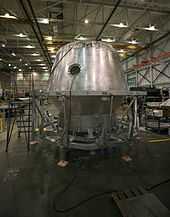
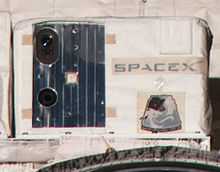
On 18 August 2006, NASA announced that SpaceX had been chosen, along with Kistler Aerospace, to develop cargo launch services for the ISS.[33] The initial plan called for three demonstration flights of SpaceX's Dragon spacecraft to be conducted between 2008 and 2010.[34][35] SpaceX and Kistler were to receive up to $278 million and $207 million respectively,[35] if they met all NASA milestones, but Kistler failed to meet its obligations, and its contract was terminated in 2007.[36] NASA later re-awarded Kistler's contract to Orbital Sciences.[36][37]
On 23 December 2008, NASA awarded a $1.6 billion Commercial Resupply Services (CRS) contract to SpaceX, with contract options that could potentially increase the maximum contract value to $3.1 billion.[38] The contract called for 12 flights to the ISS, with a minimum of 20,000 kg (44,000 lb) of cargo carried to the ISS.[38]
On 23 February 2009, SpaceX announced that its chosen heat shield material, PICA-X, had passed heat stress tests in preparation for Dragon's maiden launch.[39] PICA-X is reportedly ten times cheaper to manufacture than NASA's PICA heat shield material.[40]
The primary proximity-operations sensor for the Dragon spacecraft, the DragonEye, was tested in early 2009 during the STS-127 mission, when it was mounted near the docking port of the Space Shuttle Endeavour and used while the Shuttle approached the International Space Station. The DragonEye's LIDAR and thermal imaging capabilities were both tested successfully.[41][42] The COTS UHF Communication Unit (CUCU) and Crew Command Panel (CCP) were delivered to the ISS during the late 2009 STS-129 mission.[43] The CUCU allows the ISS to communicate with Dragon and the CCP allows ISS crew members to issue basic commands to Dragon.[43] In summer 2009, SpaceX hired former NASA astronaut Ken Bowersox as vice president of their new Astronaut Safety and Mission Assurance Department, in preparation for crews using the spacecraft.[44]
As a condition of the NASA CRS contract, SpaceX analyzed the orbital radiation environment on all Dragon systems, and how the spacecraft would respond to spurious radiation events. That analysis and the Dragon design – which uses an overall fault-tolerant triple-redundant computer architecture, rather than individual radiation hardening of each computer processor – was reviewed by independent experts before being approved by NASA for the cargo flights.[45]
Demonstration flights
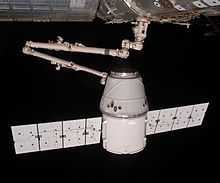
.jpg)
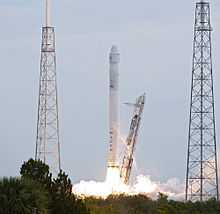
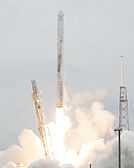
The first flight of the Falcon 9, a private flight, occurred in June 2010 and launched a stripped-down version of the Dragon capsule. This Dragon Spacecraft Qualification Unit had initially been used as a ground test bed to validate several of the capsule's systems. During the flight, the unit's primary mission was to relay aerodynamic data captured during the ascent.[46][47] It was not designed to survive re-entry, and did not.
NASA contracted for three test flights from SpaceX, but later reduced that number to two. The first Dragon spacecraft launched on its first mission – contracted to NASA as COTS Demo Flight 1 – on 8 December 2010, and was successfully recovered following reentry to Earth's atmosphere; the mission furthermore marked the second flight of the Falcon 9 launch vehicle.[48] The DragonEye sensor flew again on STS-133 in February 2011 for further on-orbit testing.[49] In November 2010, the Federal Aviation Administration (FAA) had issued a reentry license for the Dragon capsule, the first such license ever awarded to a commercial vehicle.[50]
The second Dragon flight, also contracted to NASA as a demonstration mission, launched successfully on 22 May 2012, after NASA had approved SpaceX's proposal to combine the COTS 2 and 3 mission objectives into a single Falcon 9/Dragon flight, renamed COTS 2+.[4][51] Dragon conducted orbital tests of its navigation systems and abort procedures, before being grappled by the ISS' Canadarm2 and successfully berthing with the station on 25 May to offload its cargo.[11][52][53][54][55] Dragon returned to Earth on 31 May 2012, landing as scheduled in the Pacific Ocean, and was again successfully recovered.[56][57]
On 23 August 2012, NASA Administrator Charles Bolden announced that SpaceX had completed all required milestones under the COTS contract, and was cleared to begin operational re-supply missions to the ISS.[58]
Operational flights
Dragon was launched on its first operational CRS-contract mission on 8 October 2012,[14] and completed the mission successfully on 28 October.[59]
SpaceX CRS-2, the second CRS mission from SpaceX, was successfully launched on March 1, 2013. SpaceX CRS-3, SpaceX's third CRS mission, was launched on April 18, 2014 and was berthed with the ISS from April 20, 2014 through May 18, 2014.[60] SpaceX CRS-4 successfully launched on Sunday, September 21, 2014 and berthed with the ISS on Tuesday, September 23. It splashed down in the Pacific Ocean carrying 3,276 pounds of cargo and science samples.[61]
Crewed development program
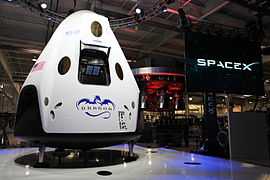
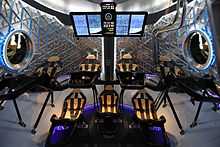
In 2006, Elon Musk stated that SpaceX had built "a prototype flight crew capsule, including a thoroughly tested 30-man-day life-support system".[32] A video simulation of this escape system's operation was released in January 2011.[26] Musk stated in 2010 that the developmental cost of a crewed Dragon and Falcon 9 would be between $800 million and $1 billion.[62] In 2009 and 2010, Musk suggested on several occasions that plans for a crewed variant of the Dragon were proceeding and had a two-to-three-year timeline to completion.[63][64] SpaceX submitted a bid for the third phase of CCDev, CCiCap.[65][66]
NASA Commercial Crew Development program
SpaceX was not awarded funding during the first phase of NASA's Commercial Crew Development (CCDev) milestone-based program. However, the company was selected on 18 April 2011, during the second phase of the program, to receive an award valued at $75 million to help develop its crew system.[67][68]
Their CCDev2 milestones involved the further advancement of the Falcon 9/Dragon crew transportation design, the advancement of the Launch Abort System propulsion design, completion of two crew accommodations demos, full-duration test firings of the launch abort engines, and demonstrations of their throttle capability.[69]
SpaceX's launch abort system received preliminary design approval from NASA in October 2011.[70] In December 2011, SpaceX performed its first crew accommodations test; the second such test is expected to involve spacesuit simulators and a higher-fidelity crewed Dragon mock-up.[71][72] In January 2012, SpaceX successfully conducted full-duration tests of its SuperDraco landing/escape rocket engine at its Rocket Development Facility in McGregor, Texas.[73]
On 3 August 2012, NASA announced the award of $440 million to SpaceX for the continuation of work on the Dragon under CCiCap.[74] As part of an optional milestone of CCiCap, the first crewed Dragon flight would occur no sooner than mid-2015.[75] This orbital flight would see Dragon being launched into a 200-nautical-mile (370-km) orbit. The first crewed mission is planned to last at least three days and be performed with a crew of three non-NASA personnel.[75] As part of another optional milestone, the first crewed Dragon flight to the ISS is planned to be launched no sooner than December 2015; this mission will also carry a non-NASA crew.[75]
In July 2013, SpaceX stated that a pad abort test is planned to occur no sooner than December 2013.[76] During this test, the Dragon capsule will use its abort engines to launch away from a test stand at Launch Complex 40.[77][78] It will travel to an altitude of 5,000 feet (1,500 m), deploy its parachutes, splashdown into the ocean and be recovered.[77][78] An in-flight abort is planned for no sooner than April 2015, which would see Dragon using its launch abort engines to escape from a Falcon 9 that is already in flight.[75][77] This test would occur at the point of worst-case dynamic loads, which is also when Dragon has the smallest performance margin for separation from its launch vehicle.[75]
On 20 December 2013, SpaceX completed a parachute drop test in order to validate the new parachute design.[79] This involved carrying a 12,000 pounds (5,400 kg) Dragon test article by helicopter to an altitude of 8,000 feet (2,400 m) above the Pacific ocean.[80] The test article was released and intentionally forced into a tumble.[80] Dragon then released its two drogue parachutes, followed by its three main parachutes and splashed down into the ocean.[80] The test article was then retrieved by helicopter and returned to shore.[80]
Red Dragon
Red Dragon is a concept for a low-cost uncrewed Mars lander that would utilize a SpaceX Falcon Heavy launch vehicle and a modified Dragon capsule to enter the Martian atmosphere. The concept will be proposed for funding in 2013 as a NASA Discovery mission, for launch in 2018.[81][82] The mission would search for the biosignatures of past or present life on Mars. Red Dragon would drill about 1 meter (3.3 ft) underground in an effort to sample reservoirs of water ice known to exist in the shallow Martian subsurface.[81][82]
A Dragon capsule is capable of performing all the entry, descent and landing (EDL) functions required to deliver payloads of 1 tonne (2,200 lb) or more to the Martian surface without using a parachute. Preliminary analysis shows that the capsule's atmospheric drag will slow it sufficiently for the final stage of its descent to be within the capabilities of its SuperDraco retro-propulsion thrusters.[81][82]
Mars One Dragon
The private Mars One colonization project developed an initial concept of using a 5-meter (16 ft)-diameter variant of Dragon, launched on a SpaceX Falcon Heavy rocket, to transport crew and cargo to the Martian surface.[83]
According to the Mars One 2014 timetable, the first launch would need to occur in July 2022, in preparation for the projected arrival of human colonists in 2025.[84][85] As of May 2013, they had no relationship with SpaceX,[86] and SpaceX has made no comment on any early Mars mission for any customers.
Development funding
In 2014, SpaceX released the total combined development costs for both the Falcon 9 launch vehicle and the Dragon capsule. NASA provided US$396 million while SpaceX provided over US$450 million to fund both development efforts.[87]
Design
Dragon CRS
For the ISS Dragon cargo flights, the ISS's Canadarm2 grapples its Flight-Releasable Grapple Fixture and berths Dragon to the station's US Orbital Segment using a Common Berthing Mechanism.[88] The CRS Dragon does not have an independent means of maintaining a breathable atmosphere for astronauts and instead circulates in fresh air from the ISS.[89] For typical missions, Dragon is planned to remain berthed to the ISS for about 30 days.[90]
The CRS Dragon's capsule can transport 3,310 kg (7,300 lb) of cargo, which can be all pressurized, all unpressurized or anywhere in between. It can return to Earth 3,310 kg (7,300 lb), which can be all unpressurized disposal mass or up to 2,500 kg of return pressurized cargo, driven by parachute limitations. There is a volume constraint of 14 m3 (490 cu ft) trunk unpressurized cargo and 11.2 m3 (400 cu ft) of pressurized cargo (up or down).[7] The trunk was first used operationally on the Dragon's CRS-2 mission in March 2013.[91] Its solar arrays produce a peak power of 4 kW.[10]
The CRS Dragon design was modified beginning with the fifth Dragon flight on the SpaceX CRS-3 mission to the ISS in March 2014. While the outer mold line of the Dragon was unchanged, the avionics and cargo racks were redesigned in order to supply substantially more electrical power to powered cargo devices, including the GLACIER and MERLIN freezer modules for transporting critical science payloads.[92]
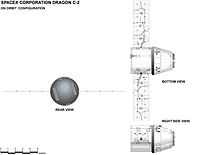

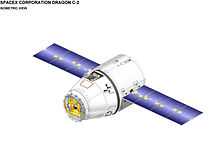
DragonLab
When used for non-NASA, non-ISS commercial flights, the uncrewed version of the Dragon spacecraft is called DragonLab.[19] It is reusable, free-flying, and capable of carrying both pressurized and unpressurized payloads. Its subsystems include propulsion, power, thermal and environmental control, avionics, communications, thermal protection, flight software, guidance and navigation systems, and entry, descent, landing, and recovery gear.[6] It has a total combined upmass of 6,000 kilograms (13,000 lb) upon launch, and a maximum downmass of 3,000 kilograms (6,600 lb) when returning to Earth.[6] As of November 2014, there were two DragonLab missions listed on the SpaceX launch manifest: one in 2016 and another in 2018.[93] The same two missions are listed on the current SpaceX manifest but no dates are shown.[94] The American Biosatellites once performed similar uncrewed payload-delivery functions, and the Russian Bion satellites still continue to do so.
Dragon V2
List of Dragon missions
List includes only completed or currently manifested missions. All NASA CRS missions are currently scheduled to launch from Cape Canaveral Launch Complex 40. Launch dates are listed in UTC.
| Mission name | Launch date (UTC) | Remarks | Outcome |
|---|---|---|---|
| SpX-C1 | 8 December 2010[95] | First Dragon mission, second Falcon 9 launch | Success[3] |
| SpX-C2+ | 22 May 2012[4] | First Dragon mission with complete spacecraft, first rendezvous mission, first berthing with ISS | Success[56] |
| SpaceX CRS-1 | 8 October 2012[15][16][96] | First Commercial Resupply Services (CRS) mission for NASA, first non-demo mission. Falcon 9 rocket suffered a partial engine failure during launch but was able to deliver Dragon into orbit.[14] However, a secondary payload did not reach its correct orbit.[97] | Mission success; launch anomaly[59] |
| SpaceX CRS-2 | 1 March 2013[98][99] | First launch of Dragon using trunk section to carry cargo.[91] Launch was successful, but anomalies occurred with the spacecraft's thrusters shortly after liftoff. Thruster function was later restored and orbit corrections were made,[98] but the spacecraft's rendezvous with the ISS was delayed from its planned date of 2 March until 3 March, when it was successfully berthed with the Harmony module.[100][101] Dragon splashed down safely in the Pacific Ocean on 26 March.[102] | Mission success; spacecraft anomaly[98] |
| SpaceX CRS-3 | 18 April 2014[103][104] | First launch of the redesigned Dragon: same outer mold line with the avionics and cargo racks redesigned in order to supply substantially more electrical power to powered cargo devices, including additional cargo freezers for transporting critical science payloads.[92] Launch rescheduled for 18 April due to a helium leak. | Mission success[105] |
| SpaceX CRS-4 | 21 September 2014[106] | First launch of a Dragon with living payload, in the form of 20 mice which are part of a NASA experiment to study the physiological effects of long-duration spaceflight.[107] | Success [108] |
| SpaceX CRS-5 | 10 January 2015[106] | Cargo manifest change due to Cygnus CRS Orb-3 launch failure.[109] Carried the Cloud Aerosol Transport System experiment. | Success |
| SpaceX CRS-6 | 14 April 2015 | Success | |
| DragonV2 abort test | NET 2015[110] | Pad abort test, Cape Canaveral Air Force Station, Florida | |
| DragonV2 abort test | NET 2015[110] | In-flight abort test, Vandenberg Air Force Base, California[75] | |
| SpaceX CRS-7 | 13 June 2015[111] | Will deliver the first of two NASA Docking System adapters to modify ISS docking ports for Commercial Crew spacecraft docking. | |
| SpaceX CRS-8 | 2 September 2015[111] | As of January 2013, will deliver the Bigelow BEAM module in the unpressurized cargo trunk.[112] | |
| SpaceX CRS-9 | 9 December 2015[111] | ||
| SpaceX CRS-10 | 2016[93] | ||
| SpaceX CRS-11 | 2016[93] | ||
| SpaceX CRS-12 | 2016[93] | ||
| SpaceX CRS-13 | 2017 | ||
| SpaceX CRS-14 | 2017 | ||
| SpaceX CRS-15 | 2017 | ||
| DragonLab Mission 1 | 2016[93] | ||
| Dragon manned mission test flight | By Dec. 2017 | Projected maximum completion date for first crewed Dragon test flight.[113] | |
| DragonLab Mission 2 | 2018[93] |
Specifications

DragonLab
The following specifications are published by SpaceX for the non-NASA, non-ISS commercial flights of the refurbished Dragon capsules, listed as "DragonLab" flights on the SpaceX manifest. The specifications for the NASA-contracted Dragon Cargo were not included in the 2009 DragonLab datasheet.[6]
- Pressure vessel
- 10 m3 (350 cu ft) interior pressurized, environmentally controlled, payload volume.[6]
- Onboard environment: 10–46 °C (50–115 °F); relative humidity 25~75%; 13.9~14.9 psia air pressure (958.4~1027 hPa).[6]
- Unpressurized sensor bay (recoverable payload)
- 0.1 m3 (4 cu ft) unpressurized payload volume.
- Sensor bay hatch opens after orbital insertion to allow full sensor access to the space environment, and closes prior to reentry to Earth's atmosphere.[6]
- Unpressurized trunk (non-recoverable)
- 14 m3 (490 cu ft) payload volume in the 2.3 m (7 ft 7 in) trunk, aft of the pressure vessel heat shield, with optional trunk extension to 4.3 m (14 ft 1 in) total length, payload volume increases to 34 m3 (1,200 cu ft).[6]
- Supports sensors and space apertures up to 3.5 m (11 ft 6 in) in diameter.[6]
- Power, communication and command systems
- Power: twin solar panels providing 1,500 W average, 4,000 W peak, at 28 and 120 VDC.[6]
- Spacecraft communications: commercial standard RS-422 and military standard 1553 serial I/O, plus Ethernet communications for IP-addressable standard payload service.
- Command uplink: 300 kbps.[6]
- Telemetry/data downlink: 300 Mbit/s standard, fault-tolerant S-band telemetry and video transmitters.[6]
Radiation tolerance
Dragon uses a "radiation-tolerant" design in the electronic hardware and software that make up its flight computers. The system uses three pairs of computers, each constantly checking on the others, to instantiate a fault-tolerant design. In the event of a radiation upset or soft error, one of the computer pairs will perform a soft reboot.[45] Including the six computers that make up the main flight computers, Dragon employs a total of 18 triple-processor computers.[45]
See also
- Comparison of space station cargo vehicles
- List of human spaceflight programs
- Space Shuttle successors
- Comparable vehicles
Cargo
- Automated Transfer Vehicle – a single-use, expendable cargo vehicle currently in use by the ESA
- Cygnus spacecraft – a single-use, expendable cargo vehicle under development by Orbital Sciences Corporation
- H-II Transfer Vehicle – an expendable cargo vehicle currently in use by JAXA
- Progress spacecraft – an expendable cargo vehicle currently in use by the Russian Federal Space Agency
Crew Tranport
- Blue Origin orbital spacecraft – an American private biconic nose cone design vehicle
- CST-100 – a spacecraft being developed by Boeing, in collaboration with Bigelow Aerospace
- Dream Chaser – a spaceplane being developed by Sierra Nevada Corporation
- Orion Multi-Purpose Crew Vehicle – a beyond-low-Earth-orbit spacecraft being developed by Lockheed Martin for NASA
- Prospective Piloted Transport System – a reusable manned spacecraft under development by the Russian Federal Space Agency
References
- ↑ "SPACEX WINS NASA COMPETITION TO REPLACE SPACE SHUTTLE" (Press release). Hawthorne, California: SpaceX. 8 September 2006. Archived from the original on 18 December 2011. Retrieved 18 December 2011.
- ↑ 2.0 2.1 Clark, Stephen (18 May 2012). "Q&A with SpaceX founder and chief designer Elon Musk". SpaceFlightNow. Retrieved 29 June 2012.
- ↑ 3.0 3.1 3.2 Bates, Daniel (9 December 2010). "Mission accomplished! SpaceX Dragon becomes the first privately funded spaceship launched into orbit and guided back to Earth". Daily Mail. London. Retrieved 9 December 2010.
- ↑ 4.0 4.1 4.2 "SpaceX Launches Private Capsule on Historic Trip to Space Station". Space.com. 22 May 2012.
- ↑ 5.0 5.1 5.2 "SpaceX Brochure – 2008" (PDF). Retrieved 9 December 2010.
- ↑ 6.0 6.1 6.2 6.3 6.4 6.5 6.6 6.7 6.8 6.9 6.10 6.11 6.12 6.13 6.14 "DragonLab datasheet" (PDF). Hawthorne, California: SpaceX. 8 September 2009. Retrieved 19 October 2010.
- ↑ 7.0 7.1 "The ISS CRS contract (signed December 23, 2008)"
- ↑ Bowersox, Ken (25 January 2011). "SpaceX Today" (PDF). SpaceX. Retrieved 13 October 2011.
- ↑ Musk, Elon (17 July 2009). "COTS Status Update & Crew Capabilities" (PDF). SpaceX. Retrieved 16 April 2012.
- ↑ 10.0 10.1 "The Annual Compendium of Commercial Space Transportation: 2012" (PDF). Federal Aviation Administration. February 2012. Retrieved 8 February 2013.
- ↑ 11.0 11.1 "SpaceX’s Dragon captured by ISS, preparing for historic berthing". NASASpaceflight.com. 25 May 2012.
- ↑ Chang, Kenneth (25 May 2012). "Space X Capsule Docks at Space Station". New York Times. Retrieved 25 May 2012.
- ↑ "SpaceX's Dragon Docks With Space Station—A First". National Geographic. 25 May 2012. Retrieved 28 May 2012.
- ↑ 14.0 14.1 14.2 "Liftoff! SpaceX Dragon Launches 1st Private Space Station Cargo Mission". Space.com. 8 October 2012 (UTC). Check date values in:
|date=(help) - ↑ 15.0 15.1 "Falcon 9 undergoes pad rehearsal for October launch". Spaceflight Now. 31 August 2012. Retrieved 12 September 2012.
- ↑ 16.0 16.1 "Worldwide Launch Schedule". Spaceflight Now. 7 September 2012. Retrieved 12 September 2012.
- ↑ "Press Briefed On the Next Mission to the International Space Station". NASA. 20 March 2012. Retrieved 11 April 2012.
- ↑ 18.0 18.1 Clark, Stephen (16 July 2010). "Second Falcon 9 rocket begins arriving at the Cape". Spaceflight Now. Retrieved 16 July 2010.
- ↑ 19.0 19.1 19.2 "Dragon Overview". SpaceX. Retrieved 16 April 2012.
- ↑ 20.0 20.1 "SpaceX Updates — December 10, 2007". SpaceX. 10 December 2007. Retrieved 11 December 2007.
- ↑ "Second Falcon 9 rocket begins arriving at the Cape". Spaceflight Now. 16 July 2010. Retrieved 4 February 2013.
- ↑ "SpaceX CRS-2 Dragon return timeline". Spaceflightnow. 26 March 2013. Retrieved 13 April 2013.
The unpressurized trunk section of the Dragon spacecraft separates. The trunk is designed to burn up on re-entry, while the pressurized capsule returns to Earth intact.
- ↑ Jones, Thomas D. (December 2006). "Tech Watch — Resident Astronaut". Popular Mechanics 183 (12): 31. ISSN 0032-4558.
- ↑ "SpaceX • COTS Flight 1 Press Kit" (PDF). SpaceX. 6 December 2010. Retrieved 29 April 2012.
- ↑ "Dragon Drop Test – August 20, 2010". Spacex.com. 20 August 2010. Retrieved 9 December 2010.
- ↑ 26.0 26.1 "Commercial Crew Development (CCDEV) video" (VIDEO). SpaceX. 14 January 2011. 3:40. Retrieved 17 January 2011.
- ↑ "Elon Musk Congressional testimony October 26, 2011" (PDF).
- ↑ "5 Fun Facts About Private Rocket Company SpaceX". Space.com. 21 May 2012. Retrieved 26 May 2012.
- ↑ Chow, Denise (8 December 2010). "Q & A with SpaceX CEO Elon Musk: Master of Private Space Dragons". Space.com (New York). Archived from the original on 18 December 2011. Retrieved 31 May 2012.
- ↑ "Fibersim helps SpaceX manufacture composite parts for Dragon spacecraft". ReinforcedPlastics.com. 15 June 2012. Retrieved 11 January 2013.
- ↑ "Production at SpaceX". SpaceX. 24 September 2013. Retrieved 29 September 2013.
- ↑ 32.0 32.1 Berger, Brian (8 March 2006). "SpaceX building reusable crew capsule". MSNBC. Retrieved 9 December 2010.
- ↑ 33.0 33.1 "NASA selects crew, cargo launch partners". Spaceflight Now. 18 August 2006. Archived from the original on 18 December 2011. Retrieved 18 December 2011.
- ↑ Thorn, Valin (11 January 2007). "Commercial Crew & Cargo Program Overview" (PDF). NASA. Retrieved 15 April 2012.
- ↑ 35.0 35.1 Boyle, Alan (18 August 2006). "SpaceX, Rocketplane win spaceship contest". MSNBC (New York). Archived from the original on 18 December 2011. Retrieved 18 December 2011.
- ↑ 36.0 36.1 Berger, Brian (19 October 2007). "Time Runs out for RpK; New COTS Competition Starts Immediately". Space.com. Archived from the original on 18 December 2011. Retrieved 9 December 2010.
- ↑ Bergin, Chris (19 February 2008). "Orbital beat a dozen competitors to win NASA COTS contract". NASASpaceflight.com. Archived from the original on 18 December 2011. Retrieved 18 December 2011.
- ↑ 38.0 38.1 "F9/Dragon Will Replace the Cargo Transport Function of the Space Shuttle after 2010" (Press release). Hawthorne, California: SpaceX. 23 December 2008. Retrieved 26 January 2009.
- ↑ "SpaceX Manufactured Heat Shield Material Passes High Temperature Tests Simulating Reentry Heating Conditions of Dragon Spacecraft" (Press release). SpaceX. 23 February 2009. Retrieved 16 July 2009.
- ↑ Chaikin, Andrew (January 2012). "1 visionary + 3 launchers + 1,500 employees = ? : Is SpaceX changing the rocket equation?". Air & Space Smithsonian. Archived from the original on 18 December 2011. Retrieved 13 November 2011.
- ↑ "UPDATE: Wednesday, September 23, 2009" (Press release). Hawthorne, California: SpaceX. 23 September 2009. Archived from the original on 18 December 2011. Retrieved 18 December 2011.
- ↑ Update: 23 September 2009. SpaceX.com. Retrieved 9 November 2012.
- ↑ 43.0 43.1 Bergin, Chris (28 March 2010). "SpaceX announce successful activation of Dragon’s CUCU onboard ISS". NASASpaceflight.com. Retrieved 27 April 2012.
- ↑ "Former astronaut Bowersox Joins SpaceX as vice president of Astronaut Safety and Mission Assurance" (Press release). SpaceX. 18 June 2009. Archived from the original on 18 December 2011. Retrieved 22 December 2012.
- ↑ 45.0 45.1 45.2 Svitak, Amy (18 November 2012). "Dragon's "Radiation-Tolerant" Design". Aviation Week. Retrieved 22 November 2012.
- ↑ Guy Norris (20 September 2009). "SpaceX, Orbital Explore Using Their Launch Vehicles To Carry Humans". Aviation Week. Retrieved 26 October 2012.
- ↑ "SpaceX Achieves Orbital Bullseye With Inaugural Flight of Falcon 9 Rocket: A major win for NASA’s plan to use commercial rockets for astronaut transport". SpaceX. 7 June 2010.
- ↑ "Private space capsule's maiden voyage ends with a splash". BBC News. 8 December 2010. Retrieved 16 November 2011.
- ↑ "STS-133: SpaceX’s DragonEye set for late installation on Discovery". NASASpaceflight.com. 19 July 2010. Retrieved 24 April 2013.
- ↑ "NASA Statements On FAA Granting Reentry License To SpaceX" (Press release). 22 November 2010. Retrieved 24 April 2013.
- ↑ Ray, Justin (9 December 2011). "SpaceX demo flights merged as launch date targeted". Tonbridge, Kent, United Kingdom: Spaceflight Now. Archived from the original on 9 December 2011. Retrieved 9 December 2011.
- ↑ "ISS welcomes SpaceX Dragon". Wired. 25 May 2012. Retrieved 13 September 2012.
- ↑ "SpaceX’s Dragon already achieving key milestones following Falcon 9 ride". NASASpaceflight.com. 22 May 2012. Retrieved 23 May 2012.
- ↑ "NASA ISS On-Orbit Status 22 May 2012". NASA via SpaceRef.com. 22 May 2012. Retrieved 23 May 2012.
- ↑ Pierrot Durand (28 May 2012). "Cargo Aboard Dragon Spacecraft to Be Unloaded On May 28". French Tribune.
- ↑ 56.0 56.1 "Splashdown for SpaceX Dragon spacecraft". BBC. 31 May 2012.
- ↑ "SpaceX Dragon Capsule opens new era". Reuters via BusinessTech.co.za. 28 May 2012. Retrieved 27 April 2013.
- ↑ "NASA Administrator Announces New Commercial Crew And Cargo Milestones". NASA. 23 August 2012. Retrieved 4 September 2012.
- ↑ 59.0 59.1 "SpaceX capsule returns with safe landing in Pacific". BBC. 28 October 2012. Retrieved 23 December 2012.
- ↑ Bergin, Chris. "SpaceX Dragon homecoming successfully concludes CRS-3 mission". NASA Spaceflight. Retrieved 19 May 2014.
- ↑ http://www.spacex.com/news/2014/11/04/spacex-completes-crs-4-mission-nasa
- ↑ "NASA expects a gap in commercial crew funding". Spaceflightnow.com. 11 October 2010. Retrieved 28 February 2011.
- ↑ "This Week in Space interview with Elon Musk". Spaceflight Now. 24 January 2010.
- ↑ "Elon Musk's SpaceX presentation to the Augustine panel". YouTube. June 2009. Retrieved 27 April 2013.
- ↑ Rosenberg, Zach (30 March 2012). "Boeing details bid to win NASA shuttle replacement". FlightGlobal. Retrieved 15 April 2012.
- ↑ "COMMERCIAL CREW INTEGRATED CAPABILITY". NASA. 23 January 2012. Retrieved 25 January 2012.
- ↑ Clark, Stephen (11 October 2010). "NASA expects a gap in commercial crew funding". Spaceflightnow. Retrieved 12 April 2012.
- ↑ Chow, Denise (18 April 2011). "Private Spaceship Builders Split Nearly $270 Million in NASA Funds". Space.com. Retrieved 12 April 2012.
- ↑ "Space Act Agreement No.NNK11MS04S between NASA and SpaceX for CCDev 2" (PDF). NASA. 18 April 2011. Retrieved 15 April 2012.
- ↑ Paur, Jason (27 October 2011). "SpaceX Launch Abort System Receives Preliminary Approval". Wired (San Francisco). Archived from the original on 18 December 2011. Retrieved 28 October 2011.
- ↑ "CCDev 2 Milestone Schedule" (PDF). NASA. 16 February 2012. Retrieved 14 April 2012.
- ↑ "ISS Update: SpaceX Space Act Agreement Status". NASA. 23 March 2012. Retrieved 14 April 2012.
- ↑ "SpaceX Tests New ‘Super’ Rocket Engines". Wired. 1 February 2012.
- ↑ "Boeing, SpaceX and Sierra Nevada Win CCiCAP Awards". Spacenews.com. 3 August 2012.
- ↑ 75.0 75.1 75.2 75.3 75.4 75.5 "Space Act Agreement NO. NNK12MSO2S between NASA and SpaceX For CCiCap". NASA/SpaceX. 24 July 2012. Retrieved 4 August 2012.
- ↑ Norris, Guy (1 July 2013). "Boeing, SpaceX Detail Capsule Test Plans". Aviation Week. Retrieved 4 July 2013.
- ↑ 77.0 77.1 77.2 Halvorson, Todd (3 July 2013). "SpaceX presses ahead on crew testing at Cape Canaveral". Florida Today. Retrieved 4 July 2013.
- ↑ 78.0 78.1 "NASA Commercial Crew Partner SpaceX Completes Two Human-Critical Reviews". NASA. 2 July 2013. Retrieved 4 July 2013.
- ↑ Messier, Doug (17 January 2014). "NASA Commercial Crew Partner SpaceX Tests Dragon Parachute System". Parabolic Arc. Retrieved 21 January 2014.
- ↑ 80.0 80.1 80.2 80.3 "NASA Commercial Crew Partner SpaceX Tests Dragon Parachute System". NASA. 17 January 2014. Retrieved 21 January 2014.
- ↑ 81.0 81.1 81.2 Wall, Mike (31 July 2011). "'Red Dragon' Mission Mulled as Cheap Search for Mars Life". Space.com. Retrieved 1 May 2012.
- ↑ 82.0 82.1 82.2 "NASA ADVISORY COUNCIL (NAC) – Science Committee Report" (PDF). NASA Ames Research Center. 1 November 2011. Retrieved 1 May 2012.
- ↑ Herkewitz, William (27 October 2015). "Why the One-Way Trip to Mars Is Doomed to Fail". Popular Mechanics. Retrieved 1 May 2015.
- ↑ Brumfield, Ben. "A one-way ticket to Mars, apply now". CNN. Cable News Network.
- ↑ "Roadmap". Mars One. Retrieved 14 January 2014.
- ↑ Shubber, Kadhim (13 May 2013). "Mars One will take you to the Red Planet, if it can raise the cash". Wired.co.uk. Retrieved 4 June 2013.
- ↑ Shotwell, Gwynne (June 4, 2014). Discussion with Gwynne Shotwell, President and COO, SpaceX. Atlantic Council. Event occurs at 12:20–13:10. Retrieved June 8, 2014.
NASA ultimately gave us about $396 million; SpaceX put in over $450 million ... [for an] EELV-class launch vehcle ... as well as a capsule
- ↑ Bergin, Chris (12 April 2012). "ISS translates robotic assets in preparation to greet SpaceX’s Dragon". NASASpaceflight.com. Retrieved 15 April 2012.
- ↑ Brenda J. Hernandez, Siarhei Piatrovich, Mauro Prina (2011). "SpaceX Dragon Air Circulation System" (PDF). SpaceX / American Institute of Aeronautics and Astronautics. Retrieved 15 April 2012.
- ↑ "NASA Advisory Council Space Operations Committee" (PDF). NASA. July 2010. Retrieved 15 April 2012.
- ↑ 91.0 91.1 Bergin, Chris (19 October 2012). "Dragon enjoying ISS stay, despite minor issues – Falcon 9 investigation begins". NASASpaceflight.com. Retrieved 21 October 2012.
CRS-2 will debut the use of Dragon’s Trunk section, capable of delivering unpressurized cargo, prior to the payload being removed by the ISS’ robotic assets after berthing.
- ↑ 92.0 92.1 Gwynne Shotwell (2014-03-21). Broadcast 2212: Special Edition, interview with Gwynne Shotwell (audio file). The Space Show. Event occurs at 18:35–19:10. 2212. Archived from the original (MP3) on 22 March 2014. Retrieved 22 March 2014.
looks the same on the outside ... new avionics system, new software, and new cargo racking system
- ↑ 93.0 93.1 93.2 93.3 93.4 93.5 "Launch Manifest". Hawthorne, California: SpaceX. 2011. Archived from the original on 20 November 2014. Retrieved 11 December 2014.
- ↑ "Launch Manifest". SpaceX. 11 December 2014. Retrieved 11 December 2014.
- ↑ "SpaceX Launches Success with Falcon 9/Dragon Flight". NASA. 9 December 2010. Retrieved 11 April 2012.
- ↑ "Private Spacecraft to Launch Space Station Cargo On Oct. 7". LiveScience. 25 September 2012.
- ↑ "Falcon 9 Drops Orbcomm Satellite in Wrong Orbit". Aviation Week. 8 October 2012. Retrieved 9 October 2012.
- ↑ 98.0 98.1 98.2 "Dragon Spacecraft Glitch Was 'Frightening,' SpaceX Chief Elon Musk Says". Space.com. 1 March 2013. Retrieved 2 March 2013.
- ↑ "Dragon Mission Report". Spaceflight Now. Retrieved 15 November 2012.
- ↑ "NASA says SpaceX Dragon is safe to dock with the International Space Station on Sunday". The Verge. 2 March 2013. Retrieved 2 March 2013.
- ↑ "SpaceX hits snag; Dragon capsule won't dock with space station on schedule". WKMG TV. 1 March 2013. Retrieved 1 March 2013.
- ↑ "SpaceX Dragon cargo ship splashes into Pacific". Boston Globe. 26 March 2013. Retrieved 28 March 2013.
- ↑ "Range Realigns – SpaceX CRS-3 mission targets April 14". NASASpaceflight.com. 4 April 2014. Retrieved 4 April 2014.
- ↑ "CRS-3 Update". http://new.livestream.com.
- ↑ "[SpaceX] Launch of SpaceX's Dragon CRS-3 Spacecraft on Falcon 9v1.1 Rocket". SpaceVids.tv. 18 April 2014. Retrieved 18 April 2014.
- ↑ 106.0 106.1 "Spaceflight Now Tracking Station". spaceflightnow.com. Retrieved 8 August 2014.
- ↑ "SpaceX Dragon Flying Mice in Space & More for NASA". Space.com. 18 September 2014. Retrieved 18 October 2014.
- ↑ "Space X Dragon capsule returns to Earth - CRS-4 Mission ends with a splash!".
- ↑ "LAUNCH OF SPACEX’S CRS-5 MISSION SLIPS TO DEC. 16, IMAGES OF LANDING ‘BARGE’ EMERGE". Spaceflight Insider. Retrieved 22 November 2014.
- ↑ 110.0 110.1 "SpaceX Prepares for Crucial Crew Dragon Capsule Pad Abort Test". universetoday.com. Retrieved 8 February 2015.
- ↑ 111.0 111.1 111.2 "Spaceflight Now Launch Schedule". spaceflightnow.com. Retrieved 5 February 2015.
- ↑ Lindsey, Clark (16 January 2013). "NASA and Bigelow release details of expandable module for ISS". NewSpace Watch. Retrieved 24 January 2013. (subscription required (help)).
- ↑ SpaceX Dragon Overview: Crew SpaceX website. Published 2014. Retrieved 14 December 2014
External links
| Wikimedia Commons has media related to Dragon (spacecraft). |
- Dragon Spacecraft overview on SpaceX official website
- SpaceX CCDev2 Agreement with NASA
- SpaceX CCDev2 bi-monthly progress reports
- Dragon cargo delivery to ISS (COTS 2 highlight reel)
- Dragon crew transport to ISS (CG rendering)
- "SpaceX Reveals Its New Dragon Space Capsule". Slate. 30 May 2014.
| ||||||||||||||
| ||||||||||||||||||||||||||||||||||||||||||||||||||||||||||||||||||||||||
| |||||||||||||||||||||||||
| |||||||||||||||||||||||||||||||||||||||||||||||||||||||||||||||||||
| ||||||||||||||||||||||||||
